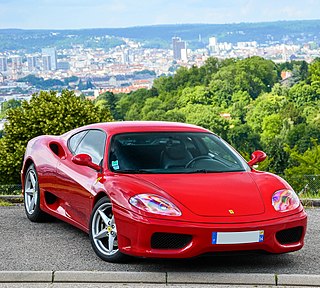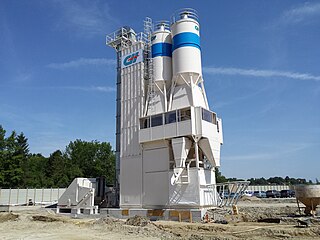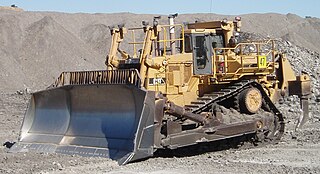

A power trowel (also known as a "power float" and "troweling machine") is a piece of light construction equipment used by construction companies and contractors to apply a smooth finish to concrete slabs. [1]


A power trowel (also known as a "power float" and "troweling machine") is a piece of light construction equipment used by construction companies and contractors to apply a smooth finish to concrete slabs. [1]
Power trowels differ in the way they are controlled:
A power trowel performs the tasks of several hand tools, hand trowel, hand float, darby and concrete float. [5]

Mechanization is the process of changing from working largely or exclusively by hand or with animals to doing that work with machinery. In an early engineering text a machine is defined as follows:
Every machine is constructed for the purpose of performing certain mechanical operations, each of which supposes the existence of two other things besides the machine in question, namely, a moving power, and an object subject to the operation, which may be termed the work to be done. Machines, in fact, are interposed between the power and the work, for the purpose of adapting the one to the other.

The Blohm & Voss BV 238 was a German flying boat, built during World War II. It was the heaviest aircraft ever built when it first flew in 1944, and was the largest aircraft produced by any of the Axis powers during World War II.

The Ferrari 360 is a two-seater, mid-engine, rear wheel drive sports car manufactured by Italian automotive manufacturer Ferrari from 1999 until 2005. It succeeded the Ferrari F355 and was replaced by the Ferrari F430 in 2004.

A jackhammer is a pneumatic or electro-mechanical tool that combines a hammer directly with a chisel. It was invented by William McReavy, who then sold the patent to Charles Brady King. Hand-held jackhammers are generally powered by compressed air, but some are also powered by electric motors. Larger jackhammers, such as rig-mounted hammers used on construction machinery, are usually hydraulically powered. These tools are typically used to break up rock, pavement, and concrete.

The Ferrari F430 is a sports car produced by the Italian automobile manufacturer Ferrari from 2004 until 2009 as a successor to the Ferrari 360. The car is an update to the 360 with exterior and performance changes. It was unveiled at the 2004 Paris Motor Show. The F430 was succeeded by the 458 which was unveiled on 28 July 2009.

An aerial work platform (AWP), also known as an aerial device, elevating work platform (EWP), aerial lift, cherry picker, bucket truck or mobile elevating work platform (MEWP) is a mechanical device used to provide temporary access for people or equipment to inaccessible areas, usually at height. There are distinct types of mechanized access platforms and the individual types may also be known as a "cherry picker", "boom lift" or "scissor lift".

A concrete mixer is a device that homogeneously combines cement, aggregate, and water to form concrete. A typical concrete mixer uses a revolving drum to mix the components. For smaller volume works, portable concrete mixers are often used so that the concrete can be made at the construction site, giving the workers ample time to use the concrete before it hardens. An alternative to a machine is mixing concrete by hand. This is usually done in a wheelbarrow; however, several companies have recently begun to sell modified tarps for this purpose.

The Caterpillar D11T is a large bulldozer introduced by Caterpillar Inc. in 1986 to replace its D10. Weighing 248,500 pounds (112,700 kg), it is Caterpillar's largest and most powerful bulldozer. Mainly used in the mining industry, it is also employed to push-load scrapers, and rip rock overburden. D11s are manufactured in East Peoria, Illinois.

The Caterpillar D10 is a bulldozer manufactured by Caterpillar Inc. between 1977 and 1987, when it was superseded by the D11. It was the first modern tractor to use the elevated drive sprocket to improve durability, operator comfort, and ease of maintenance.

The Caterpillar 797 is a series of off-highway, ultra class, two-axle, mechanical powertrain haul trucks developed and manufactured in the United States by Caterpillar Inc. specifically for high-production mining and heavy construction applications worldwide. In production since 1998, the 797 series represents Caterpillar’s largest, highest capacity haul trucks. The current, third-generation model, the 797F, offers one of the largest haul truck payload capacities in the world, up to 400 short tons (363 t) and has the highest payload capacity among mechanical drive haul trucks.

A concrete finisher is a skilled tradesperson who works with concrete by placing, finishing, protecting and repairing concrete in engineering and construction projects. Concrete finishers are often responsible for setting the concrete forms, ensuring they have the correct depth and pitch.

The Mack F series was the third generation of cabover trucks from Mack Trucks. Its production began in 1962 and ended in 1981. It was produced primarily as a set-forward axle truck but a setback axle version was shipped overseas. The cab came in a 50-inch (1371.6 mm) day cab. Sleeper models included a 72-inch (1828.8 mm), 80 inch (2032 mm) and later a "bustle back" was added that lengthened the sleeper to 86 inches (2184.4 mm).

The Dornier Do 214 was a proposed large long-range flying boat, developed by Dornier in World War II.

The Hawker Dantorp H.B. III was a Danish single-engined biplane bomber of the 1930s. The aircraft was a development of the British Hawker Horsley designed for the Danish Navy, but differed in being powered by a radial engine and having a third crew member. Two examples were built in Britain as a precursor to license production in Denmark. Financial constraints meant this was not realised and the Hawker-built examples were the only aircraft produced. They served until the German invasion of Denmark in 1940.

The Blohm & Voss Ha 140 was a German multi-purpose seaplane first flown in 1937. It was intended for use as a torpedo bomber or long-range reconnaissance aircraft but did not enter production.

The Focke-Wulf Fw 62 was a reconnaissance floatplane, designed and built by Focke-Wulf for use by Nazi Germany's Kriegsmarine. Only four were built.

The 15 cm TbtsK C/36 was a German medium-caliber naval gun deployed on Type 1936A (Mob) destroyers during the Second World War. It was designed because the Oberkommando der Marine thought that the 12.7 cm (5.0 in) guns of the Type 1936 and 1936A destroyers would potentially be inferior to those of possible enemies. The guns caused serious issues when actually placed upon the ships as they added significant weight high up on the ships. To deal with this increase in weight, the destroyers had one gun removed, sometimes with a twin gun being used in order to keep five guns.

The Porsche 981 is the internal designation given to the third-generation of the Boxster and second generation of the Cayman models built by German automobile manufacturer Porsche. It was announced on 13 March 2012 at the Geneva Auto Show with sales starting early summer 2012.

The M915 is a tractor unit used for line haul missions by the United States Army. Designed for use on improved roads it does not have a driven front axle.